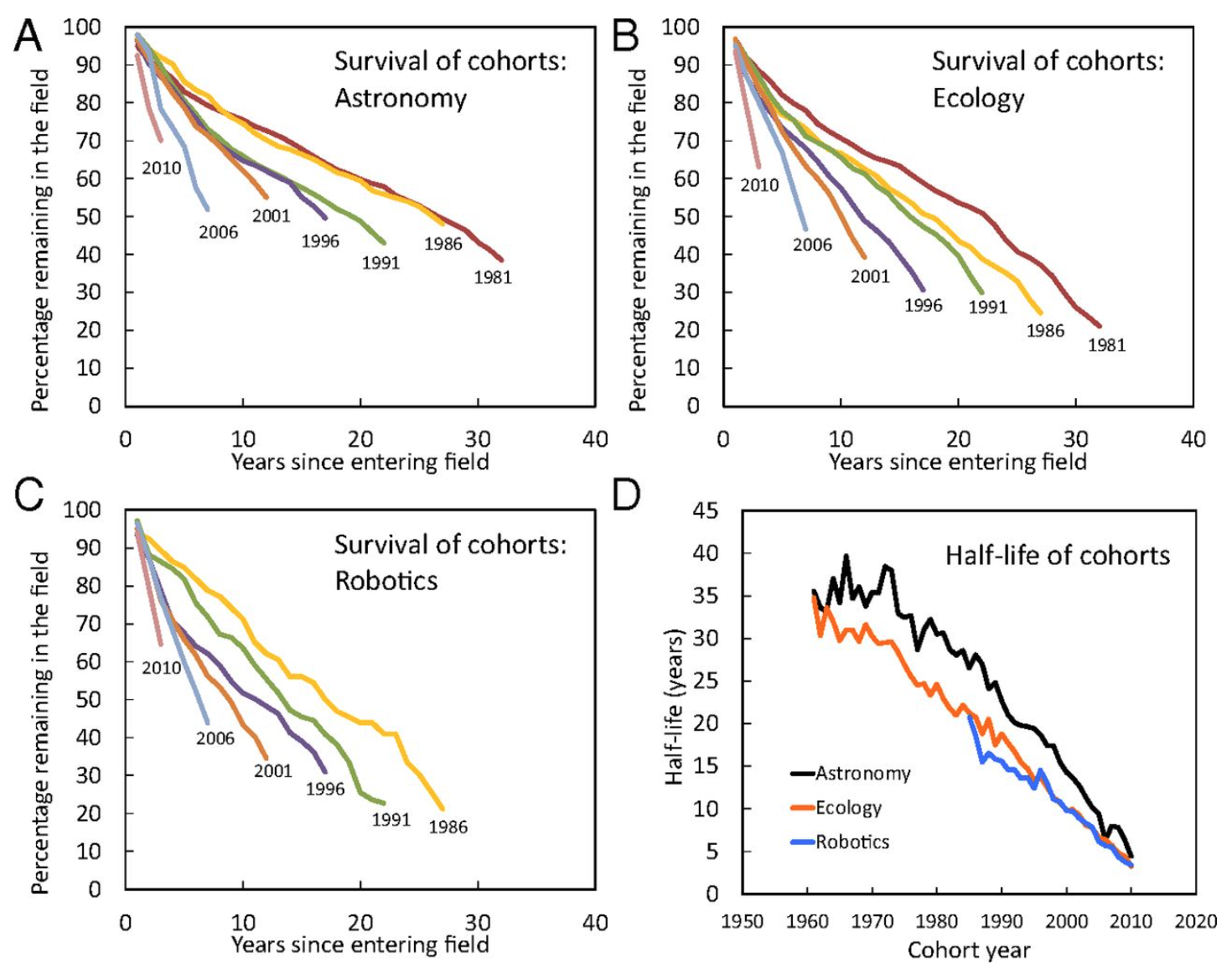New study says scientists are leaving academic work at unprecedented rate.
The “half-life” of academic scientists has shortened dramatically over time, says a new paper calling attention to the “rise of the temporary workforce.”
Following scientists in three fields, the paper’s authors found that it took about five years for a half of a science cohort to leave academic work in 2010 — compared to 35 years in the 1960s.
The researchers also found a “rapid rise” in scientists who spend their careers supporting others and never leading a paper of their own — from about 25 percent of scientists in the 1960s to 60 percent today.
“Entering graduate students should be aware of this, so that they would have realistic expectations and perhaps try to plan their lives accordingly,” lead author Staša Milojević, associate professor of informatics at Indiana University, said Monday.
While some scientists do survive and thrive, the paper says it remains somewhat unclear what drives that “survivability.”
This message is clearer: as supporting scientists become more and more essential, given the rise of team science, they’re “suffering from greater career instability and worse long-term career prospects in some fields.”
Milojević said part of the problem is postdoctoral positions, or “permadocs,” as they’re sometimes called — supposedly temporary positions on which academic research increasingly depends.
“The existence of the postdoc role has definitely changed the lab dynamics,” she said. “It has also allowed individuals to stay longer in the field in the hopes of landing a more permanent position. I believe that the existence of so many postdoc positions is leading to the attrition picture we are seeing.”
The study focused on researcher cohorts in astronomy, ecology and robotics. Researchers drew their cohorts from scientists who had published in any of the principal journals in their fields, starting in the 1960s: some 71,000 authors in astronomy, 21,000 in ecology and 18,000 in robotics. These scientists remained active authors and therefore “in” science if they’d published in a journal in any role — lead or supporting author — in the last three years covered by the study.
The researchers determined that the share of all authors who are lead authors has been trending downward in all three disciplines since the 1960s, leading to a complementary increase in the share of supporting authors.
In early cohorts in the study, about 75 percent of entering authors had a lead author role, the paper says. That figure is now about 40 percent.
For authors who persist in science beyond their first publication, the study employed a “survival analysis” to study their career longevity. Graphed survival “curves” show that until the 1980s and, for astronomy, the 1990s, half of each cohort had a “full” 20 or more years in their academic careers. In recent decades, however, there has been a continuous decline in expected career length.
Expanding the survival analysis to every cohort, the authors decided that a “half-life” would be the time it took a group of scientists to lose half its ranks. Astronomy’s half-life dropped from 37 years in the 1960s to five years in 2007. The half-lives were even shorter in ecology and robotics. Part of that difference probably reflects better nonacademic job opportunities in the latter two fields.

Source: PNAS
Attempting to track when scientists leave a field, the researchers determined that there’s no “bottleneck” stage when they rush to leave, but rather a constant trickle.
Over all, scientists who have been lead authors have significantly higher production and collaboration levels than supporting authors. Their impact levels are similar, the study says. And supporting authors, “while working on fewer papers and with fewer direct collaborators, nevertheless contribute to projects of similar impact.”
A more advanced analysis suggests that for lead authors, number of publications has “consistently been a significant predictor of career longevity. We also see that citations reduced the hazard of exit in the early cohorts.” However, the paper says, more recently, the model is “dominated by publications, with citations having little independent effect.” And in contrast, for supporting authors, publications have “very weak effects until the most recent cohort.”
While their findings are linked to the rise of group science, they’re not an “inevitable outcome of the increasing sizes of teams,” the authors say.
Going farther, the author says there is a need to reform career structures in universities to account for the changing nature of “composition and reproduction cycles in team science, with social insect colonies rather than parent-child reproduction as a more appropriate model.”
The increased need for both the “specialization and possession of specialized technical knowledge to manipulate increasingly complex instrumentation and data has created an essential group of supporting contributors to knowledge,” the paper says. “Unfortunately, the existing job roles and educational structures may not be responding to these changes.”
“Changing Demographics of Scientific Careers: The Rise of the Temporary Workforce” was published in Proceedings of the National Academy of Sciences.

0 Comments